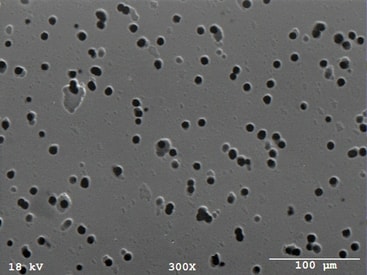An open area to discuss porosity

When discussing physical characteristics of filtration media and membranes, researchers often have questions regarding porosity. Sometimes confused with pore size, porosity is defined as the ratio of the void pore volume to the total volume of a membrane1, usually indicated as a percentage. Track-etched membranes have essentially 2-dimensional structures with well-defined pore diameters and pore densities. Consequently, their porosity is equal to the ratio of the pore area to the total surface area and is a relatively straightforward calculation. For other membrane types with complex 3-dimensional structures, it is difficult to accurately quantify porosity.
For some membrane types with consistent pore structures, porosity can be estimated using geometric analyses facilitated by scanning electron microscopy (SEM), transmission election microscopy (TEM), or atomic force microscopy (AFM)2. For microfiltration (MF) membranes, porosity is often quantified using empirical methods. Specialized devices called porometers use capillary flow porometry to characterize porosity and pore size distribution. Porometers are necessarily complex and quite expensive; and as an alternative in cases where approximations are sufficient, it is possible to simply estimate porosity by carefully measuring the mass of water, or liquid, a membrane can hold.
We understand that reliable porosity data can be useful for researchers and engineers. For example, a common area of investigation is the development of theoretical models that use porosity, among other parameters, to predict membrane fouling. When available, Sterlitech lists porosity data in the Applications/Specifications tab on product pages.
How do you use porosity in your research? Have you found porosity data to be readily available? Let us know your input below.
Porosity of various membrane filters:
Track-etched MF membranes: 1-16%
Other polymeric MF Membranes: 40-80%
UF Membranes: <7% when made by phase inversion2
References:
[1] Tarleton, E., & Wakeman, R. (2008). The dictionary of filtration and separation. Exeter: Filtration Solutions.
[2] Dietz, P., Hansma, P., Inacker, O., Lehmann, H., & Herrmann, K. (1992). Surface pore structures of micro- and ultrafiltration membranes imaged with the atomic force microscope. Journal Of Membrane Science, 65(1-2), 101-111. https://dx.doi.org/10.1016/0376-7388(92)87057-5
- Most Viewed Blog Articles (5)
- Company News (285)
- Emerging Technologies (64)
- Microbiology and Life Science News (93)
- Water and Fluid Separation News (97)
- Filtration Resources (93)
- Product News (19)


![Join Sterlitech at BIO 2024 [Booth #5558]: Exploring the Future of Biotechnology](https://www.sterlitech.com/media/blog/cache/300x200/magefan_blog/b4.jpeg)



